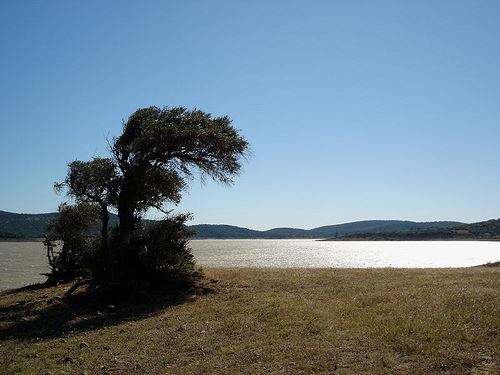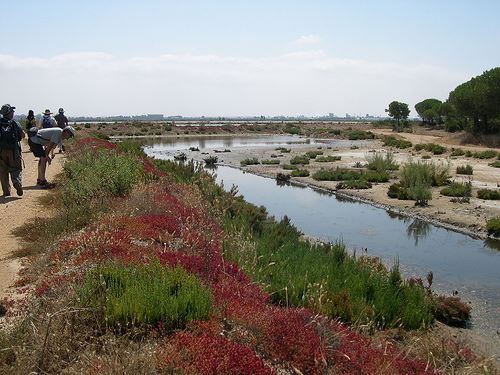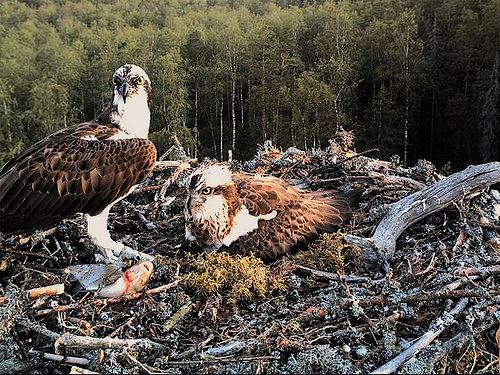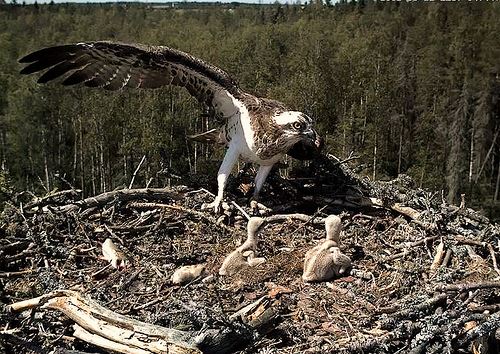Since 2002, they have been developing actions aimed at the reintroduction of the Osprey, a species lost in the Iberian Peninsula, made possible by the ability of host for this species meets the Community of Andalusia. It was in 2003 when he managed to reintroduce first four osprey chicks in Andalusia. They were born in Finland and had been installed, with six weeks of age in an artificial nest built on the banks of the reservoir of Barbate (Cádiz). After that first experience, increased the number of birds translocated to an average of twenty a year.
(Look at the picture):

"Embalse de Barbate 2", Barbate, Cadiz, South of Spain, by Alcalaina, at flickr.com
In total, from 2003 to 2011 inclusive, they have been reintroduced 164 chickens of the species between Cadiz (Barbate reservoir) and Huelva (Natural Park of the Odiel Marshes). It Is detected the return of 19 copies, thanks to the remote reading of PVC rings. It has already achieved the permanent settlement of 2 breeding pairs and at least 5 other authorities, and most importantly, have already flown 11 chickens born in Andalusia.

"Marismas del Odiel", Huelva, South of Spain, by Rafael Jiménez, at flickr.com
This project, designed and conducted scientifically by Miguel Ferrer, Research Professor of the Biological Station of Doñana and Migres Foundation President, was an initiative of the Ministry of Environment of Andalusia. Countervailing measures emerged from the highway 381, which was built between the towns of the Province of Cadiz, Jerez and Los Barrios; so that also involved the Ministry of Public Works and Transportation. Migres Foundation is currently responsible for its management and execution.
The objective of this project is to restore a landmark reintroduction breeding population of viable and self osprey in continental Spain, where breeding since the eighties (it does in the Balearic and Canary Islands). In this way also helps to promote the expansion of the Mediterranean population and reduce their risk of extinction.
The osprey is a species widely studied around the world whose population decline in the middle of the Twenty century has aroused great interest in conservation. Was extinct as breeding of mainland Spain since the 80's, while the rest (Canary and Balearic Islands) is listed as "endangered." Its conservation status in Europe is described as "unfavorable." The status of the species in the Mediterranean basin is critical since it has a sparse population and very fragmented. To increase the chances of survival of this species in the long term in the Mediterranean basin, and recover it as breeding in mainland Spain (and in the Iberian Peninsula), began the project to reintroduce the osprey in Andalusia. He had previously completed the feasibility study for the reintroduction and had prepared a detailed "Reintroduction Project."

"Macho de Aguila Pescadora con una presa", by jacilluch, at flickr.com

"Aguila Pescadora, envergadura alar", by jacilluch, at flickr.com
The proposed reintroduction of the osprey in Andalusia is an initiative of the Provincial Delegation of the Ministry of Environment in Cadiz, and was funded by it and by the Ministry of Public Works and Transportation. Doñana Biological Station (CSIC) is responsible for monitoring project scientist. The Foundation Migres is currently responsible both its direction and its technical implementation.
While preparatory work began in 2002, it was in 2003 when the first 4 chickens were released in Cadiz and it will continue at least through 2012 inclusive. Each year, in Cadiz and Huelva, they are reintroduced around a score of young fishers nests from Finland, Scotland, and Germany, making this project one of the most spectacular time of its scale, logistics and international level of cooperation few have been made to wildlife conservation in Spain. The establishment of agreements with European countries for the transfer of chickens taken from their nests, was achieved thanks to the confidence that the relevant authorities placed in the Spanish team, based both on his career as the final arguments.
With this species is used the system named hacking or farming. Between mid-June and mid July, we brought the chickens from the donor countries of northern Europe to house them in a hacking tower on the banks of the Barbate reservoir, inside the Natural Park of the Acorns or edge of a creek in the Place Odiel Marshes Natural. The chicks remain several weeks in the hacking tower until the gates open, at the time that chickens can fly, and from then until the time of migration, remain in the environment rather than loose, feeding on fish we supply, improving technique and learning to fly fish for themselves.
Previous analysis of the reintroduction project aimed to within 7 years you would get the first results taking into account the longevity of the osprey (Pandion haliaetus). Random events or the characteristics of the species may extend the waiting period. In a similar project developed in England, the first pair of osprey was played on 5 th year (2001) after its inception. However, the first successful Andalusia obtained the 2nd year project (2005) with the formation of a breeding pair in a reservoir (the Guadalcacín) located approximately 30 km from the release point (of Barbate). This breeding pair had also been running his territory during the 3rd year of the project and again laid an egg embryonated. As in 2005, the absence of the hatch, I placed two osprey chicks to 10 days old from Germany, which again managed to successfully breed until the beginning of the migration schedule. In addition to the breeding pair, there were two breeding attempts without success. Finally, in 2009 two breeding pairs, one in the Odiel Marshes Natural Park (Huelva) and another in the reservoir Guadalcacín (Cádiz) were reproduced producing three and two chickens respectively. In the years 2010 and 2011, they have been returned to play two couples (one in each release of the project site) with a production average 1.5 chicks per year. This will consolidate the return of the species as breeding in the Iberian Peninsula.
The gradual increase of observations in both areas of individuals released in the project area looking couple and makes us optimistic about the future population growth. The fact that Andalusia is also a special place in northern populations wintering favor an Andalusian population growth accelerated. It is anticipated that the establishment of breeding pairs encourage others to settle, so the population would grow exponentially.
So, after several years of effort, an extinct species in the Iberian Peninsula, it has returned to bring us. Specifically about 70 years ago disappeared from areas where it has now recurred. In the history of nature conservation in Spain, it is the first time you get back to our fauna a vertebrate extinct. It is certainly a message of hope that shows that if we can improve our natural environment and achieve a more diverse and healthy environment for future generations.
I liked this new, because I found a little miracle and a ray of hope, while we are living the hardest crisis, in History.
Some days ago, I felt pity when I listen, on the radio, that 40.000 spanish people left Spain in order to work in the rest of Europe --above all in England, France and Germany--.
But, moreover, I am proud being Spanish, because our National Soccer Team has just got 2 European Championships and one World Championships --although it is not the post importan detail (to have got those 3 tittles), no, the rea important thing is to get the just reward thanks to the effort of e team (players, technical....) directed by a gentleman so humble as Vicente del Bosque, who does not meant to be better tahn anyone, but his philosophy of life is: work, work and work.
Then, I think taht the great experience lived around the reintroduction of the Osprey in Spain, has been a successful thanks to the international cooperation beteen several countries and thanks to the confidence of the authorities from those countries, who have relied on the spanish scientists.
I wish that the economic crisis ends so soon, thanks to the confidence of differents authorities in Europe, who believe in teamwork.
Kind regards,
Luis
Sponsored by Costaluz Lawyers.
(click down...):
.jpg)